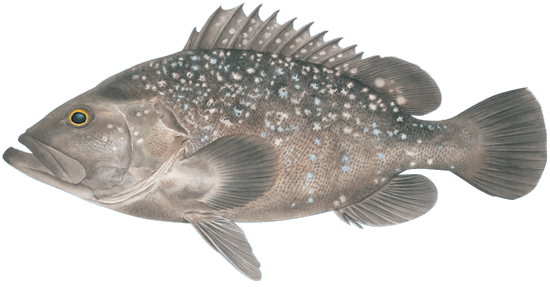
SEA BASS (HAPUʻUPUʻU)
Scientific Name: Epinephelus quernus
Hawaiian Name: Hapuʻupuʻu
Japanese Name: Mahata
Hapu`upu`u, commonly called Hawaiian sea bass or grouper, is only known to occur in the Hawaiian Islands and at seamounts just northwest of Hawaii. Groupers are able to change skin colors to blend into their natural habitat, and the hapu`upu`u is no exception. Most hapu`upu`u seen in the market are black, but fish captured in certain locations may be brownish or reddish.
Hapu`upu`u is noted for its clear white flesh that is almost as delicate in taste as that of Hawaii’s deepwater snappers.
It is a deepwater bottomfish usually caught at between 300 and 900 feet. In general, larger fish are caught at greater depths. Most of the hapu`upu`u caught off the main Hawaiian Islands are from 5 to 10 pounds in size, whereas the waters around the Northwestern Hawaiian Islands yield fish mostly in the 10 to 30 pound size range.
Hapu`upu`u keeps well when properly brined and iced.
FISHING METHOD
All Hawaii sea bass are line-caught. All sea bass are caught by deepwater handline gear with power reels.
SEASONALITY
The largest landings of hapuʻupuʻu usually occur in the fall and winter (October-December) and in the spring (February-April).
PREPARATION NOTES
Texture: Delicate
Flavor: Mild
Suggested Preparations: Steamed, Baked, Poached, Deep-Fried, Soup
In Hawaii, steaming is a favorite method of preparing hapu`upu`u, especially small fish.
HEALTH & NUTRITION
Hawaii Sea Bass, also known as hapuupuu is an excellent source of healthy, extra lean protein. It is also low in saturated fat and low in sodium. It is rich in vitamin B12 and selenium. Hawaii Sea Bass is a good source of niacin, vitamin B6 and phosphorus. Hawaii Sea Bass also provides about 250 mg of omega-3’s (DHA and EPA) per 4 ounce serving of fresh fish. Click here for nutritional labels and claims.
Click here to download a two-page description of this species.

